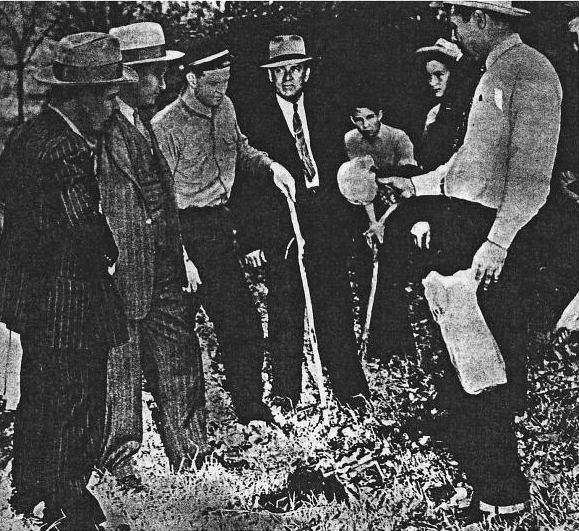
If you’re a true crime fan, you’re probably interested in serial killers. The scale of their murders and the twistedness of their minds are fascinating to anyone. Although serial killers have always existed, the concept wasn’t defined until 1975 by FBI agent Robert Ressler. The term “serial killer” entered the public lexicon during the 1981 investigation of Atlanta child killer Wayne Williams. In some ways, our view of serial murder has changed a lot throughout American history, and in many ways, it hasn’t. These books tell the tales of serial killers before modern criminology could hope to understand them.
Alfred Knapp: The First Celebrity Serial Killer in Southwest Ohio

Serial killers have been media sensations from the very beginning – just look at Alfred Knapp. He was arrested for bigamy in February 1903 after getting married to his fourth wife while his third wife, Hannah Goddard, was missing, and it didn’t take long for Knapp to confess to Hannah’s murder. The crime shocked Hamilton, Ohio, but a more stunning confession quickly followed: between 1894 and 1903, he killed three young women and girls in Cincinnatti and Indianapolis, plus his second wife, Jennie Connors, whose death was originally ruled a suicide.
Overnight, the criminal became a celebrity. So many reporters came to Hamilton that the telegram company “brought in two more operators to handle the volume of transmissions headed to newspapers around the country.” Like many serial killers after him, Knapp basked in the glow of the attention. He spoke to reporters through the bars of his cell the Thursday after his confession, detailing his crimes with both calmness and drama – “when talking about strangling his victims, his fingers would draw up with tension like talons of a bird of prey.” As Rick Kennedy wrote in his book on the case, The First Celebrity Serial Killer in Southwest Ohio, “the only action capable of keeping [Knapp’s] mouth shut was the application of 1,750 volts of electricity while he was strapped to the chair.”

Just like today, the public’s biggest question about serial murder was “Why?” Back then, they turned to physiognomy, the practice of analyzing someone’s personality based on their appearance. It’s considered a pseudoscience today, but one anonymous doctor told the Hamilton Evening Sun that “[Knapp’s] receding forehead shows lack of intellect … his manner is certainly that of a degenerate.”
We’ll never know the “why” behind Alfred Knapp’s crimes, but his celebrity foreshadowed centuries of true crime mania.
The Arkansas Hitchhike Killer: James Waybern “Red” Hall

World War II dominated American headlines in the 1940s, but that didn’t stop James Waybern “Red” Hall from drawing plenty of attention in Arkansas newspapers. After he was dishonorably discharged from the U.S. Navy in 1943, he came home to Little Rock and married 19-year-old Fayrene Clemmons. Less than a year later, Fay vanished. Hall claimed that she had deserted him, and with no evidence to suggest otherwise, she was dismissed as a runaway.
As 1945 began, police had a new mystery to solve – between January and March, three motorists were found shot dead in or near their cars, abandoned on the side of the highway. Police quickly realized the crimes were linked, and the hunt for the Hitchhike Killer began. Before long, the trail led to Red Hall. On the surface, the friendly, red-haired cab driver didn’t seem like a killer, but he admitted to all four of the murders and alluded to even more.
“The truth is, if I told you about every person I have killed, people wouldn’t believe it,” he told detectives. “There are so many, I can’t remember.”

Hall stole from all his victims, but it’s hard to tell whether the robbery was the point, or if, like the most famous serial killers, he was more psychologically driven. Before going to the electric chair in 1946, he considered donating his body to science: “Maybe they could figure out what’s wrong with me, why I did what I did.”
In her book covering Hall’s crimes, Janie Nesbitt Jones writes that “by any estimation, when Hall confessed to seventeen slayings (and insinuated more), he secured his place in the pantheon of serial killers.” Had Hall committed his crimes a few decades later, he might have gained the lasting infamy that follows Ted Bundy and Jeffrey Dahmer – but with a war on, there was no room in the public consciousness for crimes like these.
Seattle’s Forgotten Serial Killer: Gary Gene Grant

In April, 1971, Seattle was rocked by the brutal murder of two six-year-old boys, Scott Andrews and Bradley Lyons. The friends were playing outside when they vanished, only to be found days later stabbed and strangled. The clues led investigators to Gary Grant, a nineteen-year-old high school dropout. They believed that Grant might know something about the murders, but were stunned when he confessed to killing the boys himself. And those weren’t all – Grant also confessed to the murders of two teenage girls, Carol Erickson and Joanne Zuluaf, in 1969 and 1970.

These crimes took place shortly before FBI agent Robert Ressler coined the term “serial killer”. Like many of the killers Ressler studied, Grant had a traumatic childhood. During his trial, the defense argued that he faced “extreme turmoil in his early years of life” because of his mother’s alcoholism, and the “split personality” that resulted made him not guilty by reason of insanity. The jury didn’t buy it, though they did spare him the death penalty.
Grant is still alive and in prison today, but, like most of the country’s earlier serial murderers, he’s been left to fade into obscurity. About a decade after his crimes, serial killers would rise to new heights in American pop culture – and based on how popular true crime continues to be, it doesn’t look like our fascination with them will end anytime soon.
Interested in learning more about these early cases of serial murder? Read more about each below and visit our bookstore to snag a copy:

Just before Christmas 1902, Alfred Knapp strangled his wife in her sleep. He put her body in a box and sent the box floating down the Great Miami River, telling everyone that Hannah had left him. When the truth came out, Knapp confessed to four other murders. Newspapers across the Midwest sent reporters to interview the handsome strangler. Despite spending most of his adulthood in prison, he had a charming, boyish manner that made him an instant celebrity serial killer. True crime historian Richard O Jones examines the strangler’s alleged crimes, the family drama of covering up Knapp’s atrocities and how a brain-damaged drifter became a media darling.

Faulkner County native Red Hall was a serial killer who confessed to murdering at least twenty-four people. Most of his victims were motorists who picked him up as he hitchhiked around the United States. In the closing months of World War II, he beat his wife to death and went on a killing spree across the state. His signature smile lured his victims to their doom, and even after his capture, he maintained a friendly manner, being described by one lawman as “a pleasant conversationalist.” Author Janie Nesbitt Jones chronicles his life for the first time and explores reasons why he became Arkansas’s Hitchhike Killer.

“An in-depth look at the 1971 trial of a serial killer who’s been mostly forgotten — except to those who were forever impacted.”-The Seattle Times
In 1969, the body of a young woman was discovered in the woods of Renton, rocking the communities along Puget Sound. Three more brutal murders followed, drawing the attention of multiple police agencies as they tried to piece together the meager clues left behind. The seemingly unrelated cases challenged detectives, who struggled to realize they were all connected to one man: Gary Gene Grant. Before the term “serial killer” was even coined, Grant stalked his prey, destroying lives and families while walking unseen among the masses. Decades later, his crimes have all but been forgotten. Join author and homicide investigator Cloyd Steiger as he uncovers the story of the murderer who slipped through the cracks of history.



